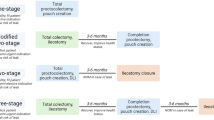Abstract
Aim
The clinical features of postoperative bleeding from the ileal pouch–anal anastomosis(IPAA) vary and its management can be difficult. There is no published literature regarding pouch bleeding and its treatment.
Materials and Methods
Pouch bleeding was defined as the passage of blood or clots transanally or into the ileostomy bag with or without hypotension or a drop in hemoglobin within 30 days after surgery. Patients were identified from a prospectively maintained pouch database.
Results
Pouch bleeding developed in 47 (1.5%) patients out of 3,194 patients undergoing IPAA since 1983. Forty-two patients had inflammatory bowel disease, four had familial adenomatous polyposis, and one had colonic inertia. Sixty-six percent of bleeding occurred within 7 days postoperatively and 59.6% required transfusion; 72.3% patients developed transanal bleeding, nine from ileostomy and two from both. After initial fluid resuscitation, five patients were observed while 28 patients had pouch endoscopy and clot evacuation followed by cauterization or epinephrine(1:100,000) enemas, 27 of these had cessation within 24 h. Epinephrine enema was used as initial treatment in the remaining 12 patients. Overall success rate of epinephrine enema was 96%.
Conclusion
Postoperative pouch bleeding after IPAA is uncommon, and it usually requires nonsurgical intervention. Epinephrine enema appears to be successful in managing this complication.

Similar content being viewed by others
References
Parks AG, Nicholls RJ. Proctocolectomy without ileostomy for ulcerative colitis. BMJ 1978;2:85–8.
Nicholls RJ. Restorative proctocolectomy with various types of reservoir. World J Surg 1987;11:751–62. doi:10.1007/BF01656598.
McHugh SM, Diamant NE, McLeod R, et al. S-pouches vs. J-pouches. A comparison of functional outcomes. Dis Colon Rectum 1987;30:671–77. doi:10.1007/BF02561686.
Utsunomiya J, Iwama T, Imajo M, Matsuo S, Sawai S, Yaegashi K, et al. Total colectomy, mucosal proctectomy, and ileoanal anastomosis. Dis Colon Rectum 1980;23:459–66.
Shen B, Fazio VW, Remzi FH, Lashner BA. Clinical approach to diseases of ileal pouch–anal anastomosis. Am J Gastroenterol 2005;100:2796–807. doi:10.1111/j.1572-0241.2005.00278.x.
Fazio VW, Ziv Y, Church JM, Oakley JR, Lavery IC, Milsom JW, et al. Ileal pouch–anal anastomoses complications and function in 1005 patients. Ann Surg 1995;222:120–7. doi:10.1097/00000658-199508000-00003.
Ballantyne GH, Pemberton JH, Beart RW Jr, Wolff BG, Dozois RR. Ileal J pouch-anal anastomosis. Current technique. Dis Colon Rectum 1985;28:197–202. doi:10.1007/BF02554246.
Farouk R, Pemberton JH, Wolff BG, et al. Functional outcomes after ileal pouch–anal anastomosis for chronic ulcerative colitis. Ann Surg 2000;231:919–26. doi:10.1097/00000658-200006000-00017.
Shen B, Remzi FH, Lavery IC, Lashner BA, Fazio VW. A proposed classification of ileal pouch disorders and associated complications after restorative proctocolectomy. Clin Gastroenterol Hepatol 2008;6:145–58. doi:10.1016/j.cgh.2007.11.006.
Hughes JP, Bauer AR Jr, Bauer CM. Stapling techniques for easy construction of an ileal J-pouch. Am J Surg 1988;155:783–5. doi:10.1016/S0002-9610(88)80043-6.
Rothenberger DA, Vermeulen FD, Christenson CE, Balcos EG, Nemer FD, Goldberg SM, et al. Restorative proctocolectomy with ileal reservoir and ileoanal anastomosis. Am J Surg 1983;145:82–8. doi:10.1016/0002-9610(83)90171-X.
Lau JY, Chung S. Management of upper gastrointestinal haemorrhage. J Gastroenterol Hepatol 2000;15(Suppl):G8–12. doi:10.1046/j.1440-1746.2000.02258.x.
Kim YI, Marcon NE. Injection therapy for colonic diverticular bleeding. A case study. J Clin Gastroenterol 1993;17:46–8. doi:10.1097/00004836-199307000-00013.
Vergara M, Calvet X, Gisbert JP. Epinephrine injection versus epinephrine injection and a second endoscopic method in high risk bleeding ulcers. Cochrane Database Syst Rev 2007;18:CD005584.
Author information
Authors and Affiliations
Corresponding author
Additional information
This abstract was presented as a poster at the Digestive Disease Week 2008, San Diego.
Rights and permissions
About this article
Cite this article
Lian, L., Serclova, Z., Fazio, V.W. et al. Clinical Features and Management of Postoperative Pouch Bleeding after Ileal Pouch–Anal Anastomosis (IPAA). J Gastrointest Surg 12, 1991–1994 (2008). https://doi.org/10.1007/s11605-008-0611-y
Received:
Accepted:
Published:
Issue Date:
DOI: https://doi.org/10.1007/s11605-008-0611-y




